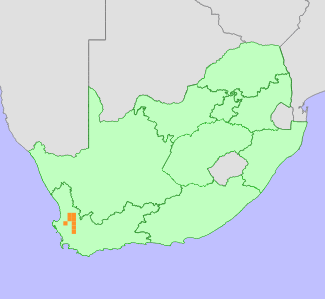|
Scientific Name | Bobartia fasciculata J.B.Gillett ex Strid |
Higher Classification | Monocotyledons |
Family | IRIDACEAE |
National Status |
Status and Criteria | Near Threatened B1ab(ii,iii,iv)+2ab(ii,iii,iv) |
Assessment Date | 2023/06/07 |
Assessor(s) | D. Raimondo & T. Patel |
Justification | Bobartia fasciculata has an extent of occurrence (EOO) of 2596-4464 km², and an area of occupancy (AOO) of 48-64 km². It is known from ten to 15 locations, although there are likely to be a few more given that this species occurs in mountainous areas. Two historical locations have been lost due to rooibos cultivation and this loss is ongoing. This species is considered to be Near Threatened (NT) based on criterion B. |
Distribution |
Endemism | South African endemic |
Provincial distribution | Western Cape |
Range | This species is endemic to the Olifants River and Elandkloof mountains in the Western Cape province of South Africa. It extends from south of Citrusdal to Hermon. |
Habitat and Ecology |
Major system | Terrestrial |
Major habitats | Fynbos |
Description | It occurs on stony sandstone slopes in fynbos or transitional renosterveld, from 350 to 750 m. |
Threats |
| This species has lost 47% of its habitat (calculated using landcover data in GIS). This habitat loss is largely as a results of rooibos tea cultivation from the top of Piqueneerskloof (Grey's Pass to Citrusdal), and on low lying flats between Porterville and Gouda. This species appears to grow on low slopes, middle slopes and plateaus. Both the plateaus and low slopes in this area have been impacted by agriculture. Habitat loss due to rooibos tea cultivation is still ongoing. |
Population |
The population exhibits a decreasing trend due to ongoing habitat loss, and is in danger of extinction. It is known from ten to 15 locations and the extent of occurrence (EOO) and area of occupancy (AOO) are therefore given as range values. It is possible that more locations remain hidden in the mountainous areas of its range.
|
Population trend | Decreasing |
Assessment History |
Taxon assessed |
Status and Criteria |
Citation/Red List version | | Bobartia fasciculata J.B.Gillett ex Strid | NT B1ab(ii,iii,iv,v) | Raimondo et al. (2009) | | Bobartia fasciculata J.B.Gillett ex Strid | Insufficiently Known | Hilton-Taylor (1996) | |
Bibliography |
Goldblatt, P. and Manning, J.C. 2000. Cape Plants: A conspectus of the Cape Flora of South Africa. Strelitzia 9. National Botanical Institute, Cape Town.
Goldblatt, P. and Manning, J.C. 2020. Iridaceae of southern Africa. Strelitzia 42. South African National Biodiversity Institute, Pretoria.
Hilton-Taylor, C. 1996. Red data list of southern African plants. Strelitzia 4. South African National Botanical Institute, Pretoria.
Raimondo, D., von Staden, L., Foden, W., Victor, J.E., Helme, N.A., Turner, R.C., Kamundi, D.A. and Manyama, P.A. 2009. Red List of South African Plants. Strelitzia 25. South African National Biodiversity Institute, Pretoria.
Strid, A. 1974. A taxonomic revision of Bobartia L. (Iridaceae). Opera Botanica 37:1-45.
|
Citation |
| Raimondo, D. & Patel, T. 2023. Bobartia fasciculata J.B.Gillett ex Strid. National Assessment: Red List of South African Plants version 2024.1. Accessed on 2025/12/13 |
 Comment on this assessment
Comment on this assessment


